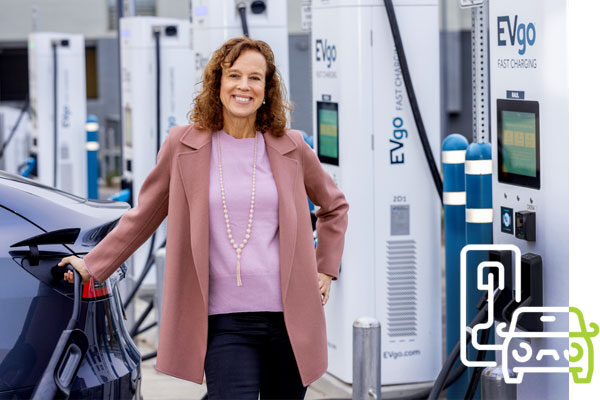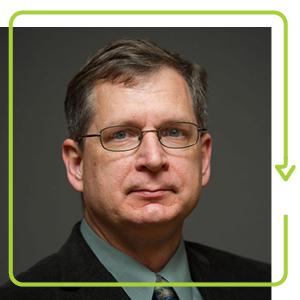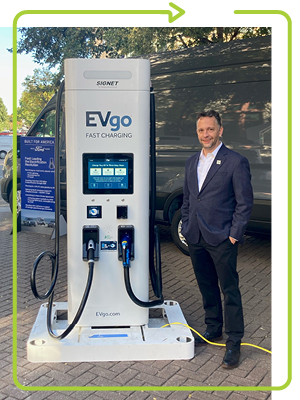Electric Uprising: EVgo charges forward to create a network of EV charging stations
Part 3 of a story in five parts about the transition to electric vehicles

Nell Oliver ’88, MBA ’93, vice president of program management and operations at EVgo

A key component in the saga of the electric vehicle has been the supremacy of gasoline as the world’s fuel of choice. Through the course of the 20th century, petroleum exerted an all-consuming monopoly over transport; the industry selling it would tolerate no competitors. That’s one reason why it’s taken a full century for electric cars, and the facilities to charge them, to return to America.
So while there are more than 150,000 fueling stations across the United States, all fitted with universally compatible unleaded gasoline and diesel pumps, electric charging stations are nowhere near as numerous. According to the U.S. Department of Energy, the nation currently has around 43,000 public EV charging stations and some 120,000 charging ports. Analysis from mobilyze.ai has revealed that only 9.7 percent of households in cities are within a quarter of a mile of an EV charging station. The charging facilities that do exist are congregated in the wealthier parts of urban centers like San Francisco, New York, and Chicago, and Black and Latino neighborhoods have significantly fewer charging stations than their white counterparts nationwide.

“The number of high-speed electric charging systems that allow multiple manufacturers’ vehicles to charge are rare and sporadic,” says Arthur Wheaton, an expert on the automotive industry at Cornell University’s School of Industrial and Labor Relations. “That leads to serious range anxiety and logistical issues planning which roads to take, to account for recharging.” Wheaton adds that the vast majority charge their vehicles at home in their garage: “That typically means a more wealthy buyer with a garage and the means to install a high-speed charger.”
Lower cost, great convenience key to mass EV adoption
EVgo’s Nell Oliver ’88, MBA ’93, and Colin Murchie ’02 plan to change all that. Oliver is vice president of program management and operations at EVgo, while Murchie is the firm’s senior director of business development. EVgo is one of the nation’s largest EV charging station providers, with more than 800 fast-charging stations across 35 states and in 68 metropolitan areas. The firm also claims to be the first charging company to be powered by 100 percent renewable energy, and it has just celebrated its 300,000th customer. The company says its mission is “to expedite mass adoption of EVs by creating a reliable, convenient and affordable charging network that delivers fast charging to everyone.”
“There are three things that need to occur for EV adoption to really take off,” Oliver says. “One is reduced battery costs, and in fact they’ve gone down dramatically just in the past five years. Second is enhanced battery performance and getting the ranges up, as well as the ability for the battery to take the charge faster.”
The third thing, Oliver says, “is absolutely the charging infrastructure. Whether it’s somebody who’s in a multi-family dwelling situation where they rely on public fast-charging; whether it’s a ride-share driver who’s driving for their job and relies on public fast-charging multiple times a day; or whether it’s someone who has home charging.”
A multiplicity of charging models
As it turns out, America’s vehicle charging network is a many-headed and complex beast. There are numerous companies in the charging space, operating an array of business models. For example, there’s Electrify America, with over 500 charging locations, which was established by Volkswagen as part of a consent decree following the infamous 2015 Dieselgate scandal. Other charging companies provide charging equipment and services to other companies.

EVgo is a little different: “We’re primarily a fast-charging, for-profit owner-operator, which may make us unique in this space,” Murchie says.
Given the uneven nature of the charging network and the multiplicity of charging business models and options, it could be argued that America’s EV charging network is something of a chaotic free-for-all. Does that complicate the effort to grow the network in an equitable way?
Murchie compares today’s EV charging network to the growth of rooftop solar. “I guess you could have called it chaos, but it still worked,” he says. “You had individual homeowners making their own decisions; solar developers making their own decisions; some of it was owned, some of it leased, some of it fee-for-service. And so there were a lot of different experiences and a lot of different models out there that worked differently for different hosts.”
Such an intricate “system of systems,” Murchie seems to imply, has enabled the charging network to grow organically, according to demand. And he believes a centrally planned approach wouldn’t work.
“I’m honestly concerned that we might over plan,” he says. “If you have a system which says ‘your station must be within 200 yards of exit 46b of I-70 in, you know, Hialeah, Florida’—I don’t think anybody quite knows enough yet about EVs to be that prescriptive in their plan.” Murchie is firmly of the view that, rather than handing the planning to transportation agencies, the continued growth of the network “should be market-led as much as possible.”
Creating an equitable network of charging stations
That very same organic, market-driven approach has created what some observers say is an uneven and unjust charging network. How does EVgo propose to redress this imbalance?
“We had to have a hard look at this,” Murchie says. “We found that we were following the signal, at a very fine geographic level, of ‘where are EVs?’” That could have led to “income clustering,” he notes, where services were being offered to wealthier neighborhoods. But it has been mitigated by EVgo’s analytical model, Muchie says. “Our model can look at a city block and say ‘We can serve all that with a charging station’ and then it can look somewhere else and say ‘These are all single-family homes, they’ll be charging at home 90 percent of the time.’”
“So we had an income signal that was heading towards unjust outcomes, but we had a housing stock signal that would tend to correct it to some degree,” Muchie says. To further correct those signals, Murchie is pushing for further quantitative modeling and geographic information systems data to take into account other factors such as air pollution.
“We knew there’d be certain structural biases that were coming in from our economic geography and the nature of our business,” he says, “so we just kind of put an explicit thumb on the scale and push it the other way.”
To round that off, Murchie says, EVgo reports quarterly on its progress in making siting decisions more equitable.
The bottom line is that EV adoption needs to take place across all of society if the full environmental and economic benefits of electrification are to be realized. With America’s charging network moving forward as a multihued patchwork quilt of operators, time will tell whether the market can self-correct to enable such a transformation.
________________________________________________________
Electric uprising: A story in five parts about the transition to electric vehicles
Learn more about the transition to EVs in other stories in this series:

Comments